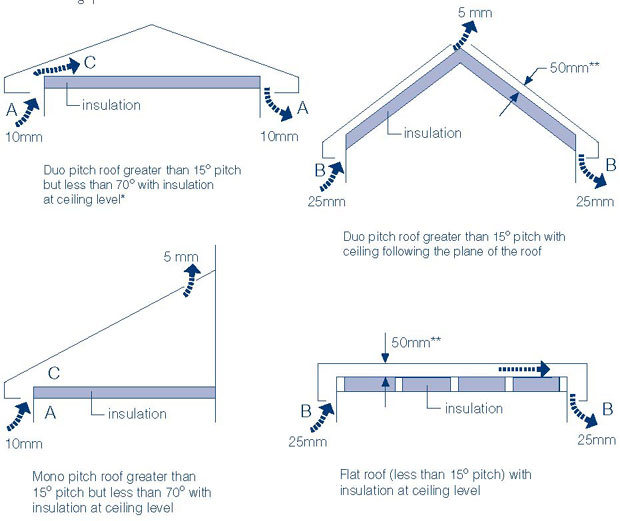Ventilation at the Eaves
Roof voids must be ventilated in order to stop warm air condensing on cold surfaces. Condensation encourages rot and mould growth. The air gap dimensions shown on the drawings are the minimum widths required for clear continuous ventilation air paths at the eaves.

*Duo pitch roofs greater than 200 pitch or greater than 10m span should have additional ventilation at the ridge to assist airflow through the roof void, equivalent to at least a 3 mm wide continuous gap. Additionally, if the span is greater than 10m the overall ventilation area should be increased to at least 0.6% of the total roof area.
**Air paths should not be obstructed. A minimum 50mm free air path should be maintained between the top of the insulation and the underside of the roof decking.
Ventilators
Swish ventilators for roof voids are covered by British Board of Agrément Certificate No.91/2620. When used in accordance with the Certificate, Swish ventilators will satisfy the following statutory requirements.
England and Wales
The Building Regulations 2000 (as amended) (England and Wales):
Requirement C2 (a) (b) (c): Resistance to Moisture
Regulation 7: Materials and workmanship.
Scotland
The Building (Scotland) Regulations 2004: (as amended)
Regulation 8: (1) (2) Fitness and durability of materials and workmanship
Regulation 9: Building Standards – Construction; Standard 3.10 – Precipitation and Standard 3.15 - Condensation
Northern Ireland
The Building Regulations (Northern Ireland) 2000, Regulation B2; (as amended)
Fitness of materials and workmanship, C4: (b) Resistance to ground moisture and weather and C5: Condensation.
Swish ventilators also meet the recommendations BS 5250: 2002 which deals comprehensively with the subject of condensation in dwellings.